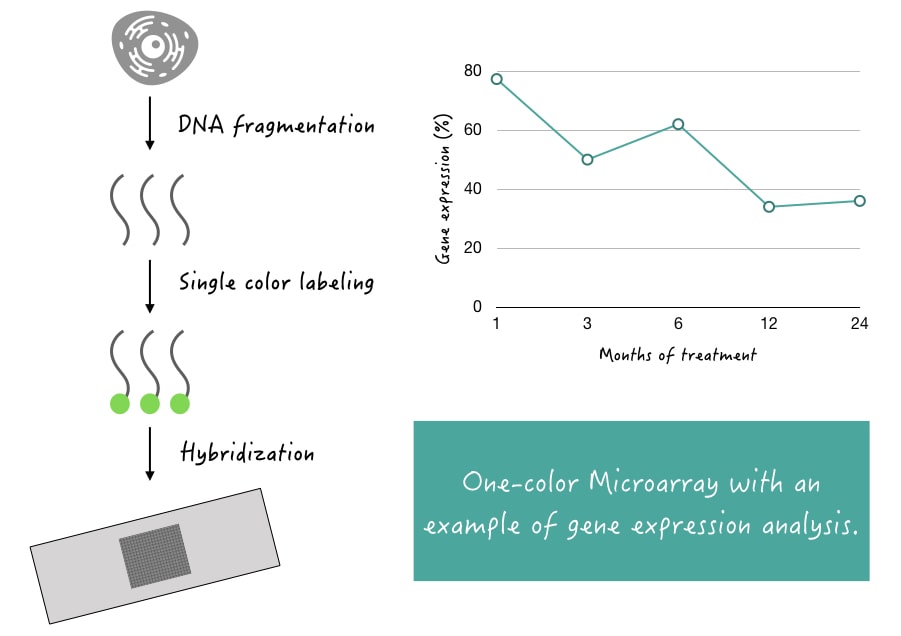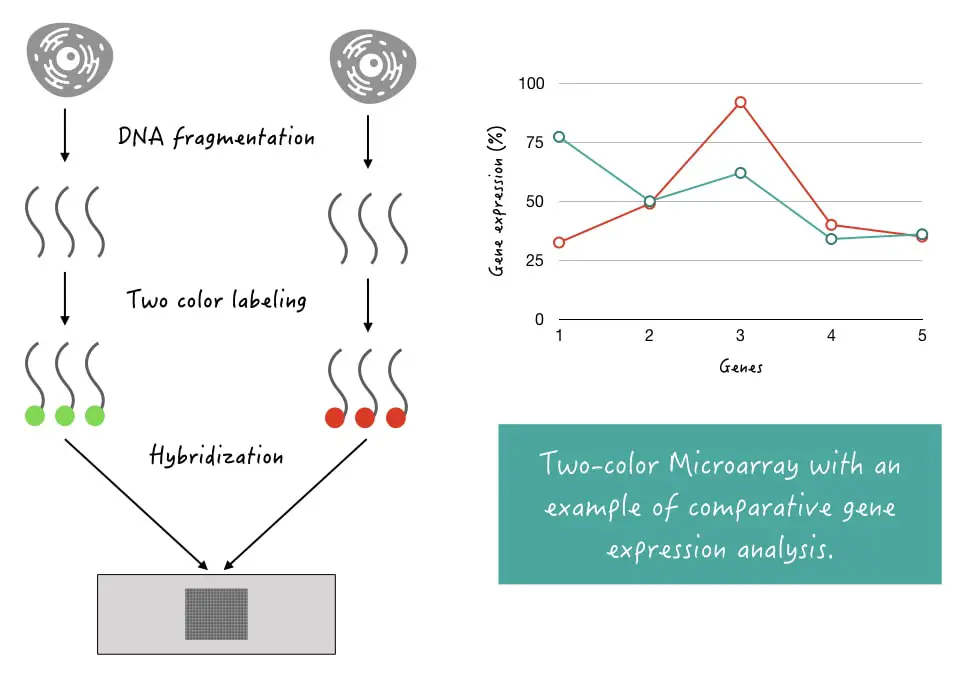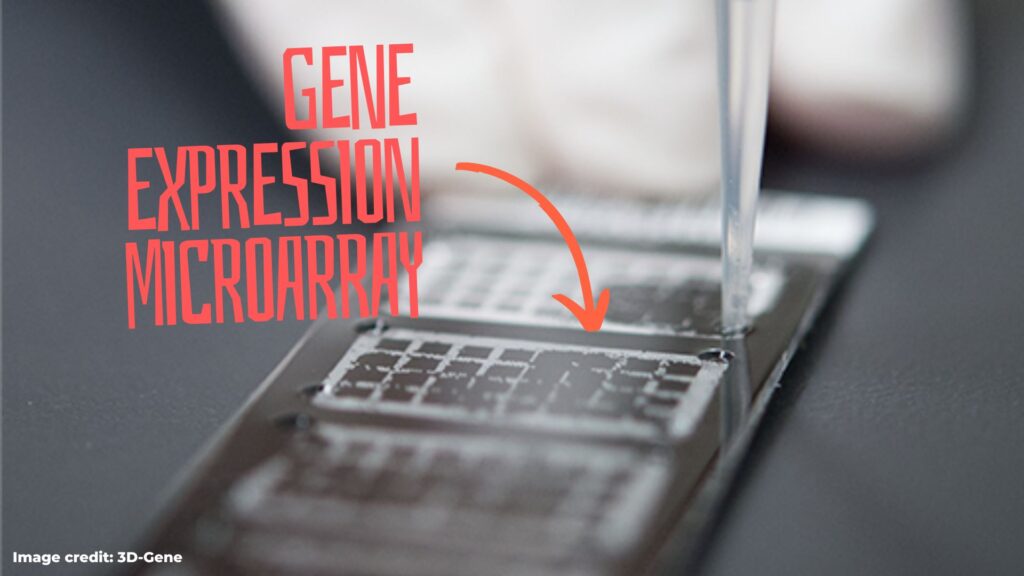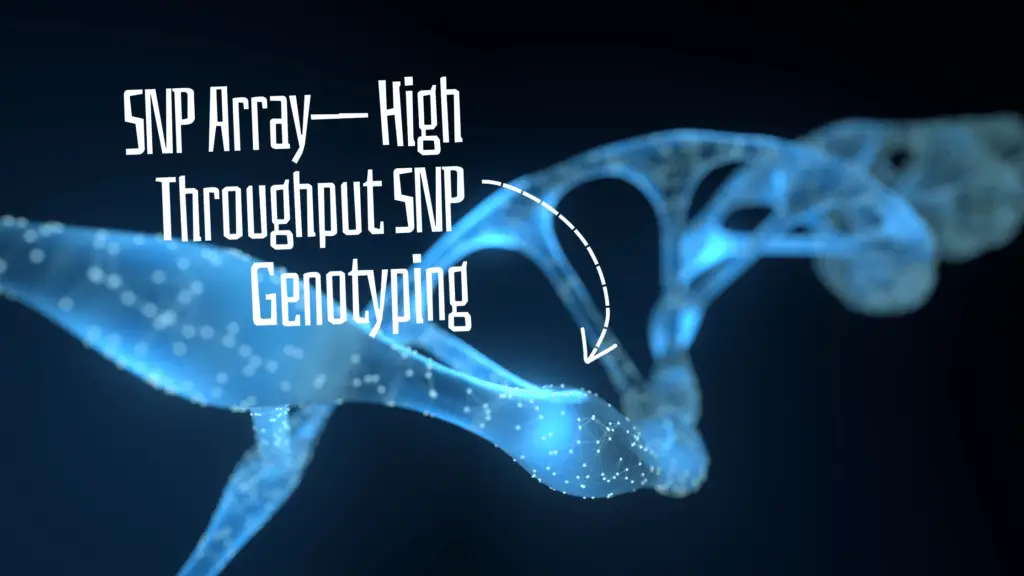“Learn about one and two-color microarrays and how and when they are used in expression studies. Explore the advantages, limitations and applications of one and two-color microarrays in this article.”
In the previous article of our microarray series, we learned about the basics of gene expression or DNA microarray and how it works. If you are new to this topic, I strongly recommend reading that article first.
Broadly, the microarray is a hybridization-based technique used for high-throughput gene expression analysis. Meaning, thousands of genes can be studied. It requires fluorescent labeling. And that’s what we are discussing in this article. The two types of microarray fluorescent labeling.
Now, in this article, we will dive deeper into this topic and learn about two important types of DNA microarrays– One and Two-color microarrays. For our convenience, we broadly say the term ‘DNA microarray.’
The name itself defines that in a one-color microarray, the fragments are labeled with a single dye while in a two-color microarray, two different dyes are used for fragment labeling. In this article, we will understand each type comprehensively.
Stay tuned.
Key Topics:
One-color DNA microarray:
Imagine, you want to study the effect of a drug after a few days, months or years or; you want to study the expression of genes under different physiological conditions. Meaning, you want to study the effect of various conditions, times or states on a single type of sample or patient.
One-color microarray is used for such kinds of studies. After fragmentation, the sample DNA is labeled with a single-colored dye. The Cy3 fluorescent label is used for one-color labeling.
After hybridization, the fluorescence signals from the sample are measured and quantified. This approach can estimate the absolute abundance of gene expression from a single sample. Let’s understand it by an example.
For example, scientists want to study the expression of various oncogenes at several intervals after the treatment. They want to evaluate the treatment outcomes after 1, 3, 6, 12 and 24 months.
So what they can do is perform a single-color DNA microarray and estimate the gene expression level, and compare it with the previous report.

Applications:
One-color microarray is widely used in differential gene expression studies, treatment outcome studies and time course studies.
Absolute gene expression studies: One-color microarray is used for absolute gene expression studies to measure gene expression between different experiments, stages, time or states. Take a look at the example given above.
Treatment Outcomes: Epigenetic-level treatment outcomes can be measured at different intervals, stages or treatments using only a single setup single-color microarray.
Biomarker Discovery: It is extensively utilized in biomarker discoveries associated with disease, disease progression, disease stages and treatment response. Meaning, scientists can evaluate, which set of genes’ expression alters during the disease state, disease progression and after treatment.
Time-course studies: Yet another crucial application of one-color microarray is in time-course dependent studies. For example, gene knockout studies where scientists can evaluate the effect of knockout at different times or developmental stages.
Henceforth, they can understand if a gene is fully or partially knocked out or not. It is also used in gene therapy and genetic engineering as well.
Advantages:
- One-color microarray is a simple technique and has a simple experimental setup and data analysis workflow.
- As it needs the least reagents, it’s comparatively cheaper than the two-color microarray.
- It also needs less starting material.
- As it requires less starting material and can allow time-course studies, it has good technical reproducibility.
- No reference sample is required for comparison which saves time, and cost and enables scientists to study a huge sample load.
- It has a wide dynamic range and can study low-abundance gene expression as well.
Disadvantages:
- The present assay can not perform a comparative analysis.
- It gives inefficient results due to the limitation of the microarray instrument and sample preparation.
- It has limited statistical power as no sample data is available for comparative study.
Two-color DNA Microarray:
Two-color microarray is extensively used in comparative genomic hybridization and comparative gene expression studies. And students know more about this one. The expression of the same set of genes or transcriptomes can be analyzed from two different sample types. For example,
- Normal vs disease sample
- Control vs patient sample
- Sample from one population vs sample from another population
- One tissue sample vs another tissue sample
In this, two different samples are fragmented and labeled with two different fluorescent dyes. Usually, Cy3 and Cy5 are employed to label each sample. Afterward, both the samples are applied to co-hybridize on the same microarray chip, under the same conditions and same time.
The gene expression level of two different samples is measured using the fluorescence emitted from each dye through hybridization. Take a look at the example.
For example, we want to study the expression profile of some genes involved in a specific type of cancer. So as aforementioned, the two-dye labeling is performed for co-hybridization of normal and cancer samples.
Suppose, the normal sample is labeled with the Cy3 (green) dye while the cancer sample is labeled with the Cy5 (red) dye. Higher expressive genes for cancer samples hybridize with more probes and give more intense red fluorescence signals.
This helps to study differential gene expression patterns for normal and cancer samples. The ratio of Cy3:Cy5 is taken into consideration to evaluate the activity.

Applications:
Comparative gene expression studies: The two-color microarray is widely used in comparative gene expression studies between two different samples, conditions or experiments.
Transcriptome preparation and analysis: It is also a good tool to prepare transcriptome for various conditions and diseases, and also helps in comparative transcriptome studies.
Cancer research: Two-color microarray is extensively employed in cancer research for differential studies of oncogenes, protooncogenes and other cancer-causing genes. Not only that, it is also used to understand the underlying mechanism behind cancer.
Pharmacogenomics and drug studies: It is also widely employed in pharmacogenomic studies to find drug response markers and perform comparative gene expression analysis for each marker.
Disease diagnosis: The present tool is immensely used in disease diagnosis and healthcare. Expression of various genes associated with particular diseases, groups of conditions and congenital conditions can be screened.
Population study: two-color microarray is extensively used in population studies to investigate transcriptomics from two different populations.
Advantages:
- It can perform an accurate estimation of gene expression by doing comparative analysis.
- It gives us more statistical power to study and interpret the data regarding gene expression.
- It reduces technical variations between samples or microarray experiments by comparing data from a single experiment.
- It has high sensitivity and better quantification.
Disadvantages:
- Two-colored microarray is comparatively a complex process that needs an additional labeling step for two different samples.
- It is also a costlier method.
- It required comparatively more starting samples to perform the microarray.
- The major limitation of the two-color microarray is that it also requires a reference value or control sample to perform a comparative study.
One vs two-color DNA microarray:
| One-color microarray | Two-color microarray |
| Requires a single fluorescent dye for labeling. | Requires two fluorescent dyes for labeling. |
| Cy3 dye is used. | Cy3 and Cy5 dyes are used. |
| Requires only a single sample. | Requires two samples– one control or reference and a patient sample. |
| Used for absolute gene expression studies. | Used for comparative gene expression studies. |
| The study can be performed at different developmental stages, experiments, times or conditions to study gene expression. | The study can be performed using two different sample types to study comparative gene expression. |
| Relative easy technique. | Relatively complex process. |
| Applications are gene expression studies, treatment outcome studies and biomarker discovery. | Applications are comparative gene expression studies, disease diagnosis, transcriptomics analysis, population studies and cancer research. |
| Can’t perform comparative analysis. | Perform comparative analysis |
| Doesn’t require a reference sample. | Require a reference sample. |
How to choose the right microarray technique?
Choosing the right technique between one-color and two-color DNA microarray depends on many factors like– the study you want to construct, use for research or diagnosis, cost of your setup, dynamic range and throughput, etc.
I am explaining some of the crucial points to make the choice clear.
Research vs diagnosis: If you want to set up a diagnostic experiment, make it clear that you want a two-color microarray platform for sensitive and accurate quantification of gene expression.
However, the one-color microarray can be utilized for research startups and absolute studies. For example, gene knockout studies.
Your experiment: It’s now clear that if you want comparative data or perform comparative studies between two samples, you have to opt for a two-color microarray, or else for other studies a single-color microarray setup is sufficient.
In addition, take into consideration the dynamic range, throughput and cost before choosing the assay. For example, the single-color microarray is cheaper, has high throughput and has a more dynamic range.
The two-color microarray is highly sensitive and has moderate throughput and a comparatively narrow dynamic range. It can’t determine high and very low abundance gene expression effectively.
Nonetheless, it’s powerful to perform comparative analysis to give us more trustable, accurate and useful data for research as well as diagnostics.
I hope this comparison will help you make your decision to choose the microarray platform. This comparison will also help those who want to design their research around microarray.
Read more: 6 Types of Microarray-based Genetic Testing.
Wrapping:
Microarray is an amazing invention in the field of genetics. It changed the entire field of genetic research as well as diagnosis as it allows us to study molecular mechanisms behind diseases.
This article is a bit technical but will surely help students and budding scientists to understand the concept. I hope you like this article. Please read the previous article of this series to get more exposure.


